Skid Resistance Performance Assessment by a PLS Regression-Based Predictive Model with Non-Standard Texture Parameters
Abstract
1. Introduction
2. An Overview of Existing Prediction Models
2.1. Empirical Models Based on Traditional Texture Characterization
2.2. Empirical Models Based on Advanced Texture Characterization
3. Materials and Methods
- Application of a new experimental method named Close-Range Orthogonal Photogrammetry (CROP) for the creation of pavement surfaces database for further roughness analysis, described in Section 3.1.
- Creation of 3D digital surface models (DSMs) from the pavement surfaces database for the analysis of roughness features on surface profiles, detailed in Section 3.2.
- Selection of relevant texture roughness parameters for the establishment of the skid resistance performance predictive model, elaborated in Section 3.3.
3.1. Pavement Surface Data Collection by the CROP Method
3.2. Digital Surface Models (DSM) Creation
3.3. Texture Data Processing and Analysis—Profile-Related and Surface-Related Texture Parameters
4. Friction Prediction Model Development
4.1. Model Development by Ridge Regression Regularization
4.2. Model Development by Principal Components Regression
4.3. Model Development by Partial Least Squares Regression
4.4. Comparison of Predicition Models’ Performance
5. Discussion
6. Conclusions
- The developed photogrammetry-based CROP method is applicable for pavement texture roughness characterization in micro- and macro-texture scale, resulting in digital surface models with sub-millimeter resolution. This makes the CROP method suitable for analysis of texture morphology on full scale of macro-texture and micro-texture up to 0.01 mm, with accuracy of 0.05 mm confirmed by a benchmark 3D data acquisition method with a high-end laser scanning device.
- Traditional texture characterization parameter MPD derived from digital surface models showed a notable correlation to measured friction, proving that digital surface models are realistically representing the actual surface roughness characteristics.
- Non-standard texture roughness parameters obtained from digital surface models are suitable predictors in the establishment of pavement texture–friction relationship. Analysis showed that the amplitude and feature parameters with the most significant impact on friction performance are maximum height Pz, describing overall roughness property and maximum peak profile height, Ppt, describing extreme roughness property of a pavement surface.
- The proposed predictive model’s performance was superior in comparison to that of the initial model defined by a single traditional texture indicator Mean Profile Depth (MPD), showing that non-standard texture parameters better describe the effect of texture roughness on frictional characteristics of a pavement surface. The obtained R2 of the proposed PLS regression model was 0.780 while the predictive model with the traditional MPD indicator obtained R2 of 0.592.
Author Contributions
Funding
Data Availability Statement
Acknowledgments
Conflicts of Interest
References
- Fwa, T.F. Determination and prediction of pavement skid resistance–connecting research and practice. J. Road Eng. 2021, 1, 43–62. [Google Scholar] [CrossRef]
- Persson, B.N.J. Theory of rubber friction and contact mechanics. J. Chem. Phys. 2001, 115, 3840–3861. [Google Scholar] [CrossRef]
- Persson, B.N.J.; Albohr, O.; Tartaglino, U.; Volokitin, A.I.; Tosatti, E. On the nature of surface roughness with application to contact mechanics, sealing, rubber friction and adhesion. J. Phys. Condens. Matter 2005, 17, R1. [Google Scholar] [CrossRef]
- Heinrich, G.; Klüppel, M. Rubber friction, tread deformation and tire traction. Wear 2008, 265, 1052–1060. [Google Scholar] [CrossRef]
- EN ISO 13473-1; Characterization of Pavement Texture by Use of Surface Profiles—Part 1: Determination of Mean Profile Depth. HZN: Zagreb, Croatia, 2004.
- Hall, J.W.; Smith, K.L.; Titus-Glover, L.; Wambold, J.C.; Yager, T.J.; Rado, Z. Guide for Pavement Friction; National Cooperative Highway Research Program; The National Academies Press: Washington, DC, USA, 2009. [Google Scholar] [CrossRef]
- Kogbara, R.B.; Masad, E.A.; Kassem, E.; Scarpas, A.; Anupam, K. A state-of-the-art review of parameters influencing measurement and modeling of skid resistance of asphalt pavements. In Construction and Building Materials; Elsevier Ltd.: Amsterdam, The Netherlands, 2016; Volume 114, pp. 602–617. [Google Scholar] [CrossRef]
- EN 13036-1; Road and Airfield Surface Characteristics—Test Methods—Part 1: Measurement of Pavement Surface Macrotexture Depth Using a Volumetric Patch Technique. HZN: Zagreb, Croatia, 2011.
- Li, Q.; Yang, G.; Wang KC, P.; Zhan, Y.; Wang, C. Novel Macro- and Microtexture Indicators for Pavement Friction by Using High-Resolution Three-Dimensional Surface Data. Transp. Res. Rec. 2017, 2641, 164–176. [Google Scholar] [CrossRef]
- EN 13036-4; Road and Airfield Surface Characteristics—Test Methods—Part 4: Method for Measurement of Slip/Skid Resistance of a Surface: The Pendulum Test. HZN: Zagreb, Croatia, 2012.
- EN 13036-2; Road and Airfield Surface Characteristics—Test Methods—Part 2: Assessment of the Skid Resistance of a Road Pavement Surface by the Use of Dynamic Measuring Systems. HZN: Zagreb, Croatia, 2011.
- Andriejauskas, T.; Vorobjovas, V.; Mielonas, V. Evaluation of skid resistance characteristics and measurement methods. In Proceedings of the 9th International Conference on Environmental Engineering, ICEE 2014, Pune, India, 21–23 February 2014. [Google Scholar] [CrossRef]
- Rajaei, S.; Chatti, K.; Dargazany, R. A review: Pavement Surface Micro-texture and its contribution to Surface Friction. In Proceedings of the Transportation Research Board 96th Annual Meeting, Washington DC, USA, 8–12 January 2017; p. 17-06773. [Google Scholar]
- Yu, M.; You, Z.; Wu, G.; Kong, L.; Liu, C.; Gao, J. Measurement and modeling of skid resistance of asphalt pavement: A review. In Construction and Building Materials; Elsevier Ltd.: Amsterdam, The Netherlands, 2020; Volume 260. [Google Scholar] [CrossRef]
- Ban, I. A Model for Skid Resistance Prediction Based on Non-Standard Pavement Surface Texture Parameters. Ph.D. Thesis, University of Rijeka Faculty of Civil Engineering, Rijeka, Croatia, 2023. [Google Scholar]
- Rezaei, A.; Masad, E. Experimental-based model for predicting the skid resistance of asphalt pavements. Int. J. Pavement Eng. 2013, 14, 24–35. [Google Scholar] [CrossRef]
- Sansoni, G.; Trebeschi, M.; Docchio, F. State-of-the-art and applications of 3D imaging sensors in industry, cultural heritage, medicine, and criminal investigation. Sensors 2009, 9, 568–601. [Google Scholar] [CrossRef] [PubMed]
- Tang, T.; Anupam, K.; Kasbergen, C.; Kogbara, R.; Scarpas, A.; Masad, E. Finite Element Studies of Skid Resistance under Hot Weather Condition. Transp. Res. Rec. 2018, 2672, 382–394. [Google Scholar] [CrossRef]
- Liu, X.; Cao, Q.; Wang, H.; Chen, J.; Huang, X. Evaluation of Vehicle Braking Performance on Wet Pavement Surface using an Integrated Tire-Vehicle Modeling Approach. Transp. Res. Rec. 2019, 2673, 295–307. [Google Scholar] [CrossRef]
- Peng, Y.; Li, J.Q.; Zhan, Y.; Wang, K.C.; Yang, G. Finite Element Method-Based Skid Resistance Simulation Using In-Situ 3D Pavement Surface Texture and Friction Data. Materials 2019, 12, 3821. [Google Scholar] [CrossRef]
- Dell’Acqua, G.; De Luca, M.; Lamberti, R. Indirect skid resistance measurement for porous asphalt pavement management. Transp. Res. Rec. 2011, 2205, 147–154. [Google Scholar] [CrossRef]
- Kargah-Ostadi, N.; Howard, A. Monitoring Pavement Surface Macrotexture and Friction: Case Study. Transp. Res. Rec. 2015, 2525, 111–117. [Google Scholar] [CrossRef]
- Kouchaki, S.; Roshani, H.; Prozzi, J.A.; Garcia, N.Z.; Hernandez, J.B. Field Investigation of Relationship between Pavement Surface Texture and Friction. Transp. Res. Rec. 2018, 2672, 395–407. [Google Scholar] [CrossRef]
- Islam, S.; Hossain, M.; Miller, R. Evaluation of pavement surface texture at the network level. Nondestruct. Test. Eval. 2019, 34, 87–98. [Google Scholar] [CrossRef]
- Li, Q.J.; Zhan, Y.; Yang, G.; Wang, K.C.P. Pavement skid resistance as a function of pavement surface and aggregate texture properties. Int. J. Pavement Eng. 2020, 21, 1159–1169. [Google Scholar] [CrossRef]
- Chou, C.P.; Lee, C.C.; Chen, A.C.; Wu, C.Y. Using a constructive pavement texture index for skid resistance screening. Int. J. Pavement Res. Technol. 2017, 10, 360–368. [Google Scholar] [CrossRef]
- Yang, G.; Li, Q.J.; Zhan, Y.J.; Wang KC, P.; Wang, C. Wavelet based macrotexture analysis for pavement friction prediction. KSCE J. Civ. Eng. 2018, 22, 117–124. [Google Scholar] [CrossRef]
- Pranjić, I.; Deluka-Tibljaš, A.; Cuculić, M.; Šurdonja, S. Influence of pavement surface macrotexture on pavement skid resistance. Transp. Res. Procedia 2020, 45, 747–754. [Google Scholar] [CrossRef]
- Ergun, M.; Iyinam, S.; Iyinam, A.F. Prediction of road surface friction coefficient using only macro- and microtexture measurements. J. Transp. Eng. 2005, 131, 311–319. [Google Scholar] [CrossRef]
- Ahammed, M.A.; Tighe, S.L. Asphalt pavements surface texture and skid resistance—Exploring the reality. Can. J. Civ. Eng. 2012, 39, 1–9. [Google Scholar] [CrossRef]
- Kotek, P.; Kováč, M. Comparison of valuation of skid resistance of pavements by two device with standard methods. Procedia Eng. 2015, 111, 436–443. [Google Scholar] [CrossRef]
- Meegoda, J.N.; Gao, S. Evaluation of pavement skid resistance using high speed texture measurement. J. Traffic Transp. Eng. 2015, 2, 382–390. [Google Scholar] [CrossRef]
- Pomoni, M.; Plati, C.; Loizos, A.; Yannis, G. Investigation of pavement skid resistance and macrotexture on a long-term basis. Int. J. Pavement Eng. 2022, 23, 1060–1069. [Google Scholar] [CrossRef]
- Bitelli, G.; Simone, A.; Girardi, F.; Lantieri, C. Laser scanning on road pavements: A new approach for characterizing surface texture. Sensors 2012, 12, 9110–9128. [Google Scholar] [CrossRef] [PubMed]
- Luhmann, T.; Robson, S.; Kyle, S.; Harley, I. Close Range Photogrammetry. 2006. Available online: https://www.researchgate.net/publication/237045019_Close_Range_Photogrammetry_Principles_Techniques_and_Applications (accessed on 5 April 2023).
- Puzzo, L.; Loprencipe, G.; Tozzo, C.; D’Andrea, A. Three-dimensional survey method of pavement texture using photographic equipment. Meas. J. Int. Meas. Confed. 2017, 111, 146–157. [Google Scholar] [CrossRef]
- Tian, X.; Xu, Y.; Wei, F.; Gungor, O.; Li, Z.; Wang, C.; Li, S.; Shan, J. Pavement macrotexture determination using multi-view smartphone images. Photogramm. Eng. Remote Sens. 2020, 86, 643–651. [Google Scholar] [CrossRef]
- Mathavan, S.; Kamal, K.; Rahman, M. A Review of Three-Dimensional Imaging Technologies for Pavement Distress Detection and Measurements. IEEE Trans. Intell. Transp. Syst. 2015, 16, 2353–2362. [Google Scholar] [CrossRef]
- Chen, S.; Liu, X.; Luo, H.; Yu, J.; Chen, F.; Zhang, Y.; Ma, T.; Huang, X. A state-of-the-art review of asphalt pavement surface texture and its measurement techniques. J. Road Eng. 2022, 2, 156–180. [Google Scholar] [CrossRef]
- Sha, A.; Yun, D.; Hu, L.; Tang, C. Influence of sampling interval and evaluation area on the three-dimensional pavement parameters. Road Mater. Pavement Des. 2021, 22, 1964–1985. [Google Scholar] [CrossRef]
- Song, W. Correlation between morphology parameters and skid resistance of asphalt pavement. Transp. Saf. Environ. 2022, 4, tdac002. [Google Scholar] [CrossRef]
- Zou, Y.; Yang, G.; Huang, W.; Lu, Y.; Qiu, Y.; Wang, K.C.P. Study of pavement micro-and macro-texture evolution due to traffic polishing using 3d areal parameters. Materials 2021, 14, 5769. [Google Scholar] [CrossRef]
- Gonzalez-Jorge, H.; Solla, M.; Armesto, J.; Arias, P. Novel method to determine laser scanner accuracy for applications in civil engineering. Opt. Appl. 2012, 42, 43–53. [Google Scholar] [CrossRef]
- EN ISO 21920-2; Geometrical Product Specifications (GPS)—Surface Texture: Profile—Part 2: Terms, Definitions and Surface Texture Parameters. HZN: Zagreb, Croatia, 2022.
- EN ISO 25178-2; Geometrical Product Specifications (GPS)—Surface Texture: Areal—Part 2: Terms, Definitions and Surface Texture Parameters. HZN: Zagreb, Croatia, 2014.
- Zuniga-Garcia, N.; Prozzi, J.A. High-Definition Field Texture Measurements for Predicting Pavement Friction. Transp. Res. Rec. 2019, 2673, 246–260. [Google Scholar] [CrossRef]
- Callai, S.C.; De Rose, M.; Tataranni, P.; Makoundou, C.; Sangiorgi, C.; Vaiana, R. Microsurfacing Pavement Solutions with Alternative Aggregates and Binders: A Full Surface Texture Characterization. Coatings 2022, 12, 1905. [Google Scholar] [CrossRef]
- Kogbara, R.B.; Masad, E.A.; Woodward, D.; Millar, P. Relating surface texture parameters from close range photogrammetry to Grip-Tester pavement friction measurements. Constr. Build. Mater. 2018, 166, 227–240. [Google Scholar] [CrossRef]
- Alhasan, A.; Smadi, O.; Bou-Saab, G.; Hernandez, N.; Cochran, E. Pavement Friction Modeling using Texture Measurements and Pendulum Skid Tester. Transp. Res. Rec. 2018, 2672, 440–451. [Google Scholar] [CrossRef]
- Huyan, J.; Li, W.; Tighe, S.; Sun, Z.; Sun, H. Quantitative Analysis of Macrotexture of Asphalt Concrete Pavement Surface Based on 3D Data. Transp. Res. Rec. 2020, 2674, 732–744. [Google Scholar] [CrossRef]
- Li, L.; Wang, K.C.P.; Li, Q.J. Geometric texture indicators for safety on AC pavements with 1 mm 3D laser texture data. Int. J. Pavement Res. Technol. 2016, 9, 49–62. [Google Scholar] [CrossRef]
- Hu, L.; Yun, D.; Liu, Z.; Du, S.; Zhang, Z.; Bao, Y. Effect of three-dimensional macrotexture characteristics on dynamic frictional coefficient of asphalt pavement surface. Constr. Build. Mater. 2016, 126, 720–729. [Google Scholar] [CrossRef]
- Chen, D. Evaluating asphalt pavement surface texture using 3D digital imaging. Int. J. Pavement Eng. 2020, 21, 416–427. [Google Scholar] [CrossRef]
- Kováč, M.; Brna, M.; Decký, M. Pavement Friction Prediction Using 3D Texture Parameters. Coatings 2021, 11, 1180. [Google Scholar] [CrossRef]
- Tadić, A.; Ružić, I.; Krvavica, N.; Ilić, S. Post-Nourishment Changes of an Artificial Gravel Pocket Beach Using UAV Imagery. J. Mar. Sci. Eng. 2022, 10, 358. [Google Scholar] [CrossRef]
- Ružić, I.; Marović, I.; Benac, Č.; Ilić, S. Coastal cliff geometry derived from structure-from-motion photogrammetry at Stara Baška, Krk Island, Croatia. Geo-Mar. Lett. 2014, 34, 555–565. [Google Scholar] [CrossRef]
- Over, J.S.; Ritchie, A.C.; Kranenburg, C.J.; Brown, J.A.; Buscombe, D.; Noble, T.; Sherwood, C.R.; Warrick, J.; Wernette, P. Processing Coastal Imagery with Agisoft Metashape Professional Edition, Version 1.6—Structure from Motion Workflow Documentation; U.S. Geological Survey: Reston, VA, USA, 2021.
- Akoglu, H. User’s guide to correlation coefficients. Turk. J. Emerg. Med. 2018, 18, 91–93. [Google Scholar] [CrossRef]
- Fredricks, G.; Nelsen, R.B. On the relationship between Spearman’s rho and Kendall’s tau for pairs of continuous random variables. J. Stat. Plan. Inference 2007, 137, 2143–2150. [Google Scholar] [CrossRef]
- Yoo, W.; Mayberry, R.; Bae, S.; Singh, K.; Lillard, J.W. A Study of Effects of MultiCollinearity in the Multivariable Analysis. Int. J. Appl. Sci. Technol. 2014, 4, 9. [Google Scholar] [PubMed]
- Schreiber-Gregory, D.N. Ridge Regression and multicollinearity: An in-depth review. Model Assist. Stat. Appl. 2018, 13, 359–365. [Google Scholar] [CrossRef]
- Hastie, T.; Tibshirani, R.; Friedman, J. The Elements of Statistical Learning, 2nd ed.; Springer: Berlin/Heidelberg, Germany, 2009; Available online: https://hastie.su.domains/Papers/ESLII.pdf (accessed on 15 March 2023).
- James, G.; Witten, D.; Hastie, T.; Tibshirani, R. An Introduction to Statistical Learning with Applications in R, 2nd ed.; Springer: Berlin/Heidelberg, Germany, 2021. [Google Scholar]
- Maitra, S.; Yan, J. Principle Component Analysis and Partial Least Squares—Two Dimension Reduction Techniques for Regression. 2008. Available online: https://www.semanticscholar.org/paper/Principle-Component-Analysis-and-Partial-Least-Two-Maitra-Yan/8276a0c6d57335a18547776fcfa7be639c13b822#cited-papers (accessed on 10 April 2023).
- Gwelo, A.S. Principal components to overcome multicollinearity problem. Oradea J. Bus. Econ. 2019, 4, 79–91. [Google Scholar] [CrossRef]
- Joshi, K.; Patil, B. Prediction of Surface Roughness by Machine Vision using Principal Components based Regression Analysis. Procedia Comput. Sci. 2020, 167, 382–391. [Google Scholar] [CrossRef]
- Liu, C.; Zhang, X.; Nguyen, T.T.; Liu, J.; Wu, T.; Lee, E.; Tu, X.M. Partial least squares regression and principal component analysis: Similarity and differences between two popular variable reduction approaches. Gen. Psychiatry 2022, 35, e100662. [Google Scholar] [CrossRef]
- Tran, T.N.; Afanador, N.L.; Buydens LM, C.; Blanchet, L. Interpretation of variable importance in Partial Least Squares with Significance Multivariate Correlation (sMC). Chemom. Intell. Lab. Syst. 2014, 138, 153–160. [Google Scholar] [CrossRef]
- Chen, J.; Huang, X.; Zheng, B.; Zhao, R.; Liu, X.; Cao, Q.; Zhu, S. Real-time identification system of asphalt pavement texture based on the close-range photogrammetry. Constr. Build. Mater. 2019, 226, 910–919. [Google Scholar] [CrossRef]
- Medeiros, M.; Babadopulos, L.; Maia, R.; Castelo Branco, V. 3D pavement macrotexture Parameters from close range photogrammetry. Int. J. Pavement Eng. 2023, 24, 2020784. [Google Scholar] [CrossRef]
- Čelko, J.; Kováč, M.; Kotek, P. Analysis of the Pavement Surface Texture by 3D Scanner. Transp. Res. Procedia 2016, 14, 2994–3003. [Google Scholar] [CrossRef]
- Wang, Y.; Yang, Z.; Liu, Y.; Sun, L. The characterisation of three-dimensional texture morphology of pavement for describing pavement sliding resistance. Road Mater. Pavement Des. 2019, 20, 1076–1095. [Google Scholar] [CrossRef]
- Mahboob Kanafi, M.; Kuosmanen, A.; Pellinen, T.K.; Tuononen, A.J. Macro-and micro-texture evolution of road pavements and correlation with friction. Int. J. Pavement Eng. 2015, 16, 168–179. [Google Scholar] [CrossRef]
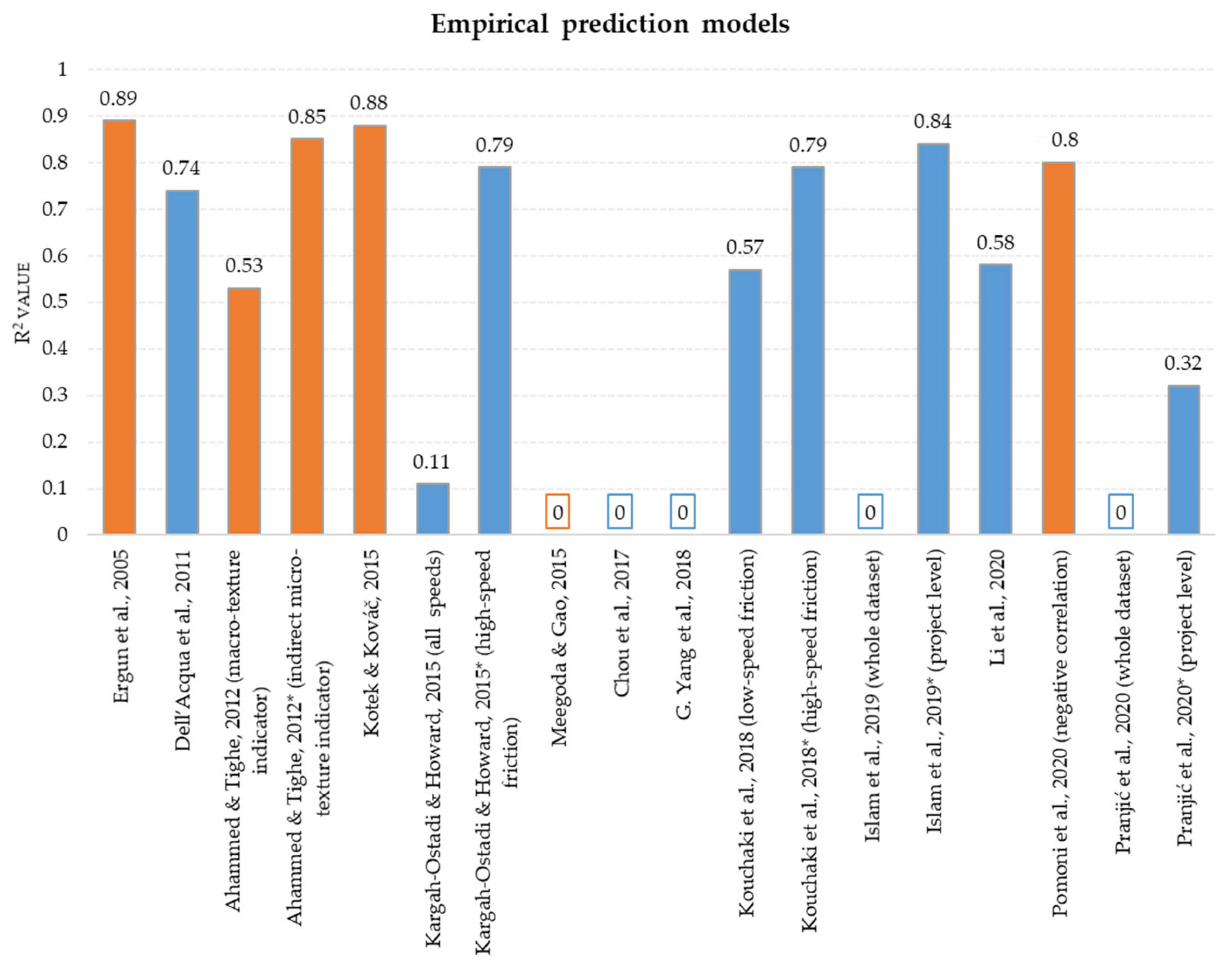

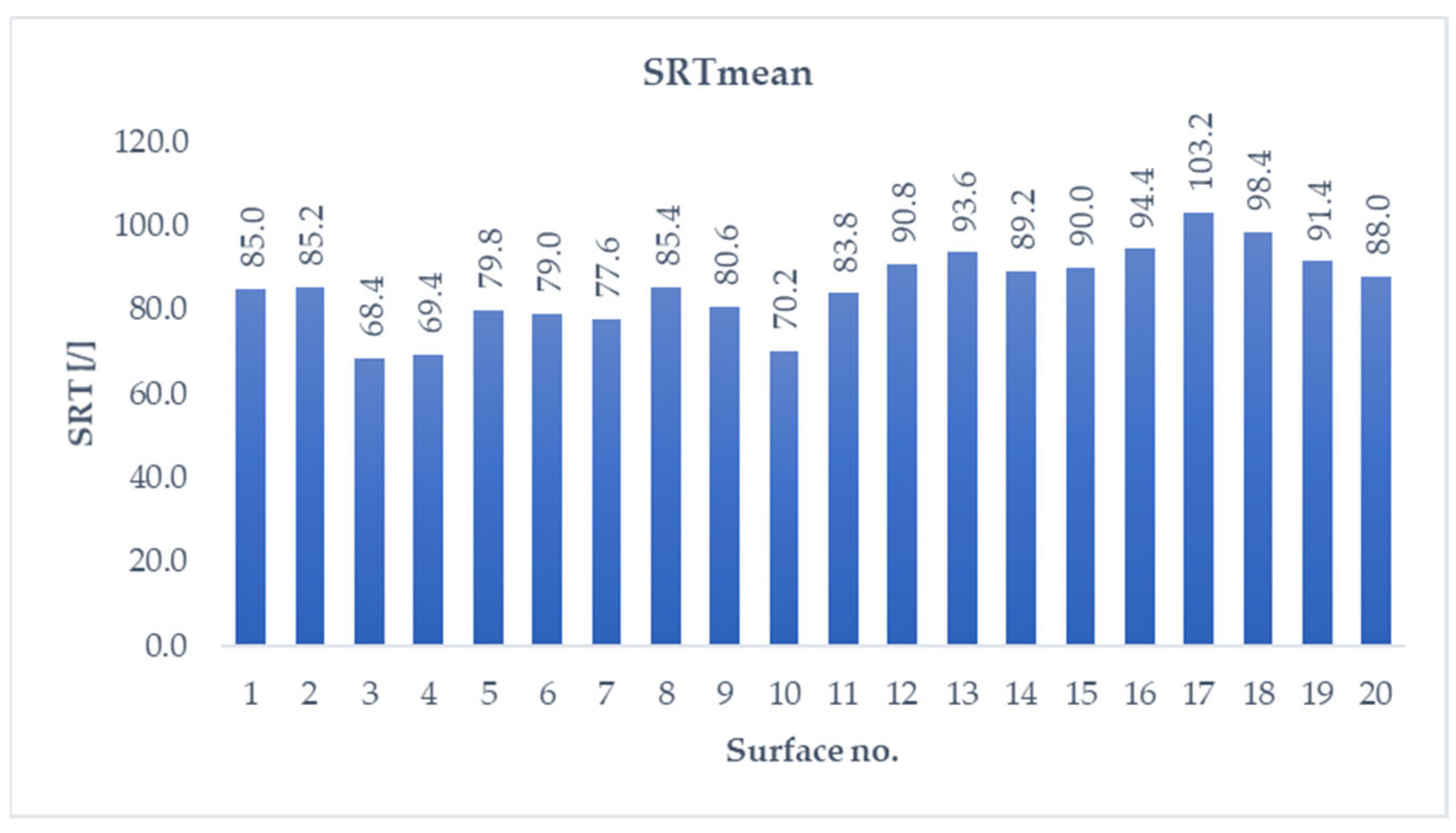
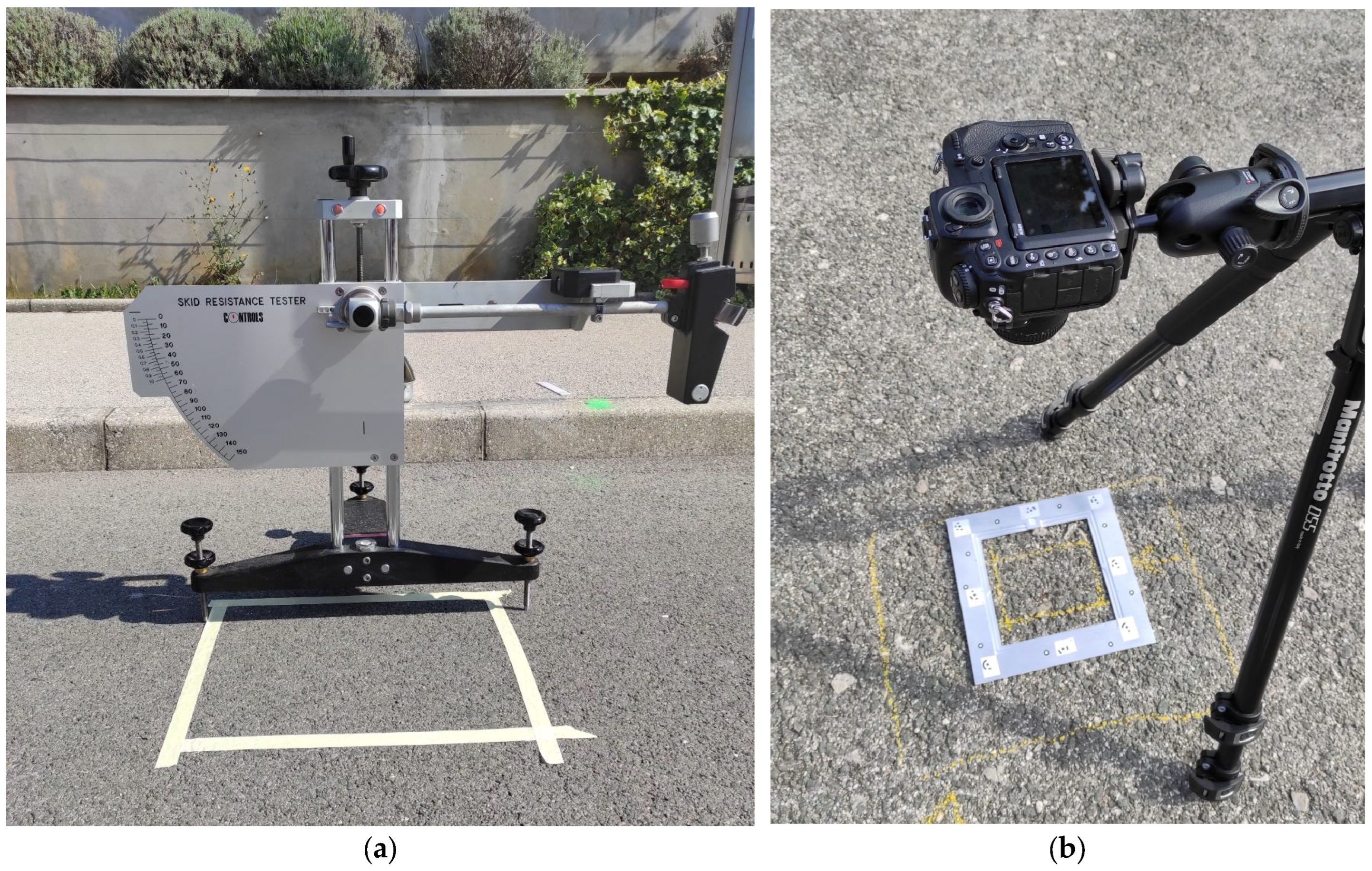
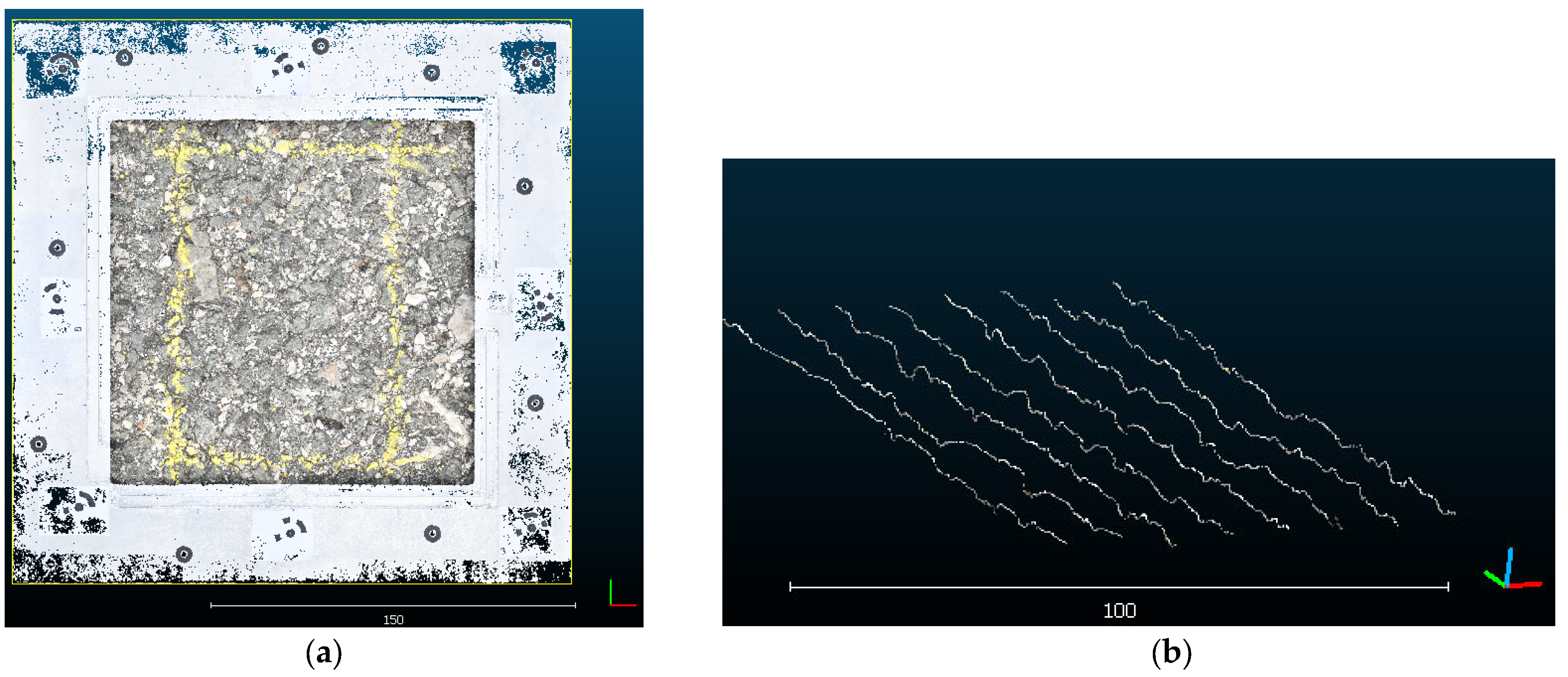


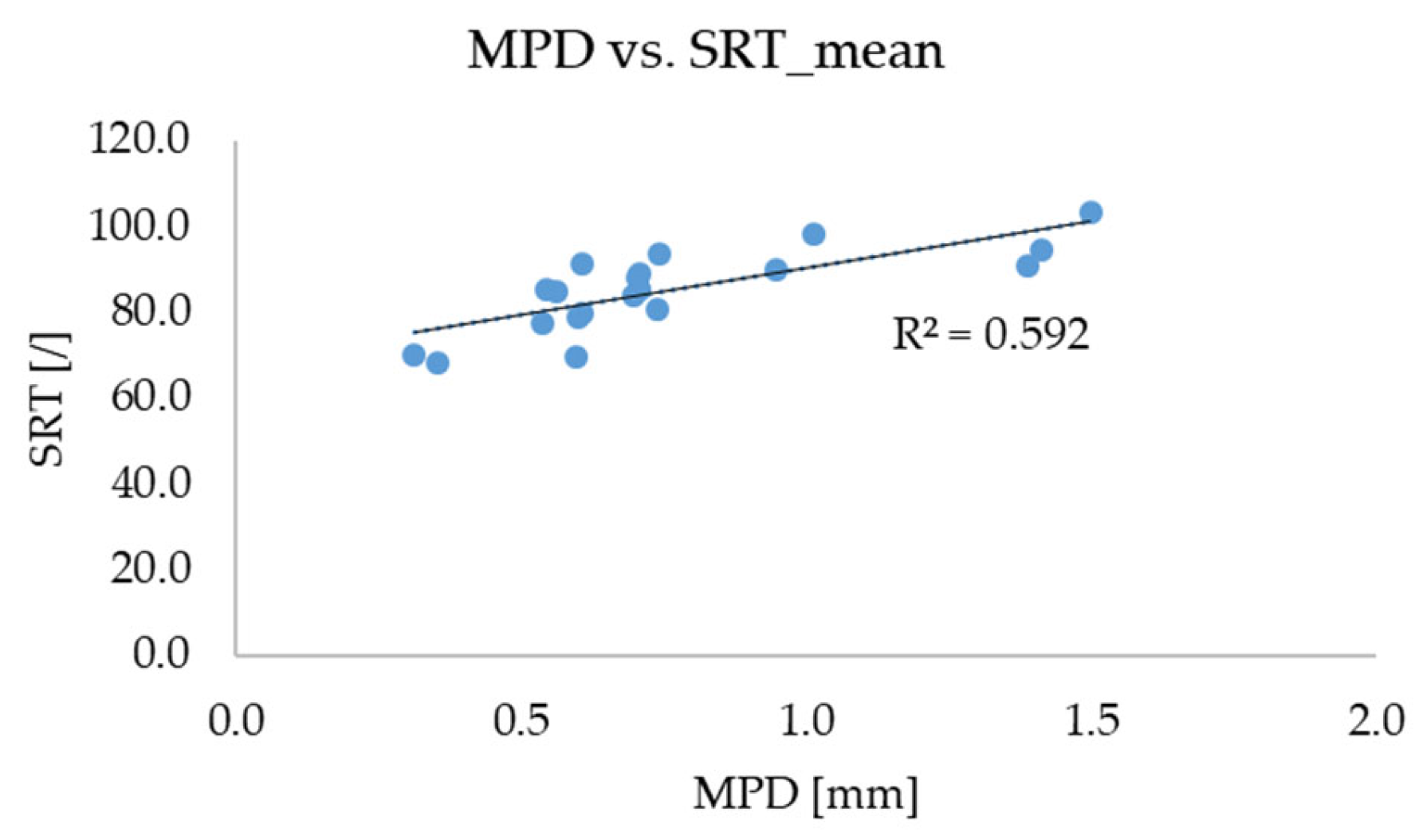

| Authors | Data Collection Method | Model Parameters | Results |
|---|---|---|---|
| Kogbara et al., 2018 [48] | Photogrammetry-based | Surface-related texture roughness parameters for different texture scales | Obtained R2 = 0.75 for predictive model accounting for two selected parameters calculated for top 2 mm of pavement surface |
| Alhasan et al., 2018 [49] | 3D laser scanner | Fractal characterization of texture roughness by the PSD function and the Hurst exponent, MPD | Obtained R2 = 0.71 for predictive model accounting for fractal characteristics of pavement surfaces in combination with the traditional MPD indicator |
| Huyan et al., 2020 [50] | Photogrammetry-based | Profile-related roughness parameters and MTD | Obtained R2 > 0.7 for predictive model accounting for two profile-related indicators and MTD for low-speed friction measurements |
| L. Li et al., 2016 [51] | 3D laser scanner | Surface-related texture rough-ness parameters from EN ISO 25178-2 | Obtained R2 = 0.95 for predictive models accounting for six selected roughness parameters of pavement surfaces |
| Hu et al., 2016 [52] | 3D laser scanner | Surface-related texture rough-ness parameters from EN ISO 25178-2, surface fractal dimension | Obtained R2 = 0.76–0.83 for predictive models accounting for two selected roughness parameters of pavement surfaces, while fractal dimension showed no significant effect to the model’s predictive strength |
| Chen D., 2020 [53] | Photogrammetry based | Spectral texture indicators related to profiles and MTD | Obtained R2 = 0.88 for predictive model accounting for spectral texture indicator in wavelength range related to micro-texture and low-speed friction measurements |
| Li, Q.J. et al., 2020 [25] | 3D laser scanner | Surface-related texture roughness parameters (multiscale) and aggregate feature, amplitude and material parameters | Obtained R2 = 0.78 for predictive model accounting for selected roughness parameters texture entropy and aggregate feature parameter |
| Kovač et al., 2021 [54] | 3D laser scanner | Surface-related texture roughness parameters on micro and macro level from EN ISO 25178-2 | Obtained R2 = 0.84 for predictive model accounting for three micro-texture-related parameters and one macro-texture parameter |
| Texture Parameter | Abbreviation | Description |
|---|---|---|
| Arithmetic mean height [mm] | Pa | Arithmetic mean of absolute ordinate values on the profile evaluation length le |
| Root mean square height [mm] | Pq | Square root of the mean square of the ordinate values on the profile evaluation length le |
| Maximum height [mm] | Pz | Mean value of the per section sum of largest peak height and pit depth for all section lengths |
| Total height [mm] | Pt | Sum of the largest height and largest depth on the profile evaluation length le |
| Skewness | Psk | Quotient of the mean cube value of the ordinate values and Pq cube value |
| Kurtosis | Pku | Quotient of the mean quartic value of the ordinate values and fourth power Pq value |
| Mean profile element spacing [mm] | Psm | Mean value of profile elements spacing for a total number of profile elements |
| Maximum profile element spacing [mm] | Psmx | Maximum profile elements spacing on the evaluation length |
| Maximum peak height [mm] | Ppt | Largest peak height of all section lengths ls |
| Maximum pit depth [mm] | Pvt | Largest pit depth of all section lengths ls |
| Mean profile element height [mm] | Pc | Mean value of profile element heights Zt for a total number of profile elements |
| Maximum profile element height [mm] | Pcx | Maximum value of profile element heights Zt for a total number of profile elements |
| Variables | Pq | Psk | Pku | Pt | Ppt | Pvt | Pz | Pa | Psm | Psmx | Pc | Pcx | MPD |
|---|---|---|---|---|---|---|---|---|---|---|---|---|---|
| Pq | 1 | ||||||||||||
| Psk | −0.202 | 1 | |||||||||||
| Pku | −0.198 | −0.416 | 1 | ||||||||||
| Pt | 0.827 | −0.269 | −0.055 | 1 | |||||||||
| Ppt | 0.674 | 0.043 | −0.308 | 0.655 | 1 | ||||||||
| Pvt | 0.726 | −0.403 | 0.047 | 0.837 | 0.495 | 1 | |||||||
| Pz | 0.835 | −0.174 | −0.194 | 0.792 | 0.679 | 0.692 | 1 | ||||||
| Pa | 0.932 | −0.158 | −0.261 | 0.769 | 0.684 | 0.673 | 0.818 | 1 | |||||
| Psm | 0.247 | −0.198 | 0.098 | 0.268 | 0.176 | 0.292 | 0.168 | 0.225 | 1 | ||||
| Psmx | 0.190 | −0.118 | 0.001 | 0.212 | 0.168 | 0.220 | 0.105 | 0.179 | 0.486 | 1 | |||
| Pc | 0.834 | −0.226 | −0.152 | 0.802 | 0.634 | 0.735 | 0.817 | 0.808 | 0.300 | 0.186 | 1 | ||
| Pcx | 0.792 | −0.271 | −0.057 | 0.840 | 0.604 | 0.789 | 0.753 | 0.742 | 0.259 | 0.227 | 0.787 | 1 | |
| MPD | 0.713 | 0.031 | −0.319 | 0.670 | 0.879 | 0.518 | 0.722 | 0.728 | 0.173 | 0.135 | 0.673 | 0.620 | 1 |
| Variables | Pq | Pa | Pz | Pc | Pt | Ppt | Pvt | Pcx | MPD | SRTmean |
|---|---|---|---|---|---|---|---|---|---|---|
| Pq | 1 | |||||||||
| Pa | 0.968 | 1 | ||||||||
| Pz | 0.884 | 0.895 | 1 | |||||||
| Pc | 0.947 | 0.937 | 0.937 | 1 | ||||||
| Pt | 0.737 | 0.726 | 0.747 | 0.789 | 1 | |||||
| Ppt | 0.632 | 0.663 | 0.684 | 0.642 | 0.537 | 1 | ||||
| Pvt | 0.632 | 0.621 | 0.600 | 0.663 | 0.811 | 0.368 | 1 | |||
| Pcx | 0.779 | 0.768 | 0.768 | 0.811 | 0.874 | 0.516 | 0.789 | 1 | ||
| MPD | 0.684 | 0.695 | 0.758 | 0.716 | 0.547 | 0.800 | 0.442 | 0.589 | 1 | |
| SRTmean | 0.389 | 0.421 | 0.484 | 0.421 | 0.358 | 0.653 | 0.232 | 0.358 | 0.663 | 1 |
| Regression Model | Model Parameters | Adjusted R2 | RMSE | Note |
|---|---|---|---|---|
| LR | MPD | 0.592 | 6.162 | Moderate linear relationship between MPD and friction |
| MLRv1 | Pa, Pz, Pc, Ppt | 0.760 | 3.987 | Pa was found to be statistically insignificant |
| MLRv2 | Pz, Pc, Ppt | 0.762 | 4.581 | Pa was found to be statistically insignificant, Pc was attributed with a negative coefficient (contrary to the previous correlation analysis where a monotonic positive relationship with friction was detected) |
| MLRv3 | Pz, Pc | 0.720 | 4.970 | Multicollinearity for predictor variables (VIF > 10), Pc was attributed with a negative coefficient |
| Regression Model | Penalty Term | Model Predictors | Adjusted R2 | Note |
|---|---|---|---|---|
| Ridge (k = 5) | 0.6873 | Pa, Pz, Pc, Ppt | 0.684 | 5-fold cross-validation (initial) |
| Ridge (k = 10) | 0.5464 | Pa, Pz, Pc, Ppt | 0.600 | 10-fold cross-validation (initial) |
| Ridge (k = 5)V1 | 0.6800 | Pa, Pz, Pc, Ppt | 0.694 | Optimization by Z-score test outlier removal, penalty term updated |
| Ridge (k = 5)V2 | 0.812 | Pz, Ppt | 0.768 | Optimization by removal of predictors with negative coefficients (Pa and Pc), penalty term updated |
| Principal Component | Eigen Value | Variability [%] | Pa Contribution [%] | Pz Contribution [%] | Pc Contribution [%] | Ppt Contribution [%] |
|---|---|---|---|---|---|---|
| PC1 | 3.736 | 93.403 | 26.033 | 26.054 | 25.969 | 21.944 |
| PC2 | 0.232 | 5.796 | 5.744 | 5.889 | 10.661 | 77.676 |
| PC3 | 0.024 | 0.603 | 53.127 | 46.703 | 0.168 | 0.002 |
| PC4 | 0.008 | 0.197 | 15.066 | 21.355 | 63.201 | 0.378 |
| Regression Model | Model Predictors | VIF | Model Equation | Adjusted R2 | Note |
|---|---|---|---|---|---|
| PCAv1 | PC1, PC2 | 1.040 | SRT = 85.170 − 1.217 Pa − 1.239 Pz − 2.186 Pc + 11.402 Ppt | 0.569 | Initial model with 2 PCs resulted in negative coefficients associated to some predictors |
| PCAv2 | PC1 | n.a. | SRT = 85.17 + 1.679 Pa + 1.681 Pz + 1.676 Pc + 1.541 Ppt | 0.503 | A Z-score outlier test performed to detect and remove outliers |
| PCAv3 | PC1 | n.a. | SRT = 85.8609 + 1.8917 Pa + 1.8937 Pz + 1.8898 Pc + 1.7363 Ppt | 0.667 | Final model iteration |
| Regression Model | Model Predictors | LV’s Global Contribution to the Model (Q2cumulative) | LV’s Explanatory Power for Model Predictor (R2Xcumulative) | LV’s Explanatory Power for Model Output (R2Ycumulative) | Model Equation | Note |
|---|---|---|---|---|---|---|
| PLSv1 | Pa, Pz, Pc, Ppt | 0.376 | 0.975 | 0.510 | SRT = 85.17 + 1.6005 Pa + 1.6997 Pz + 1.5177 Pc + 1.8086 Ppt | Initial model with weaker performance than LR model |
| PLSv2 | Pa, Pz, Pc, Ppt | 0.479 | 0.978 | 0.594 | SRT = 85.9813 + 1.5896 Pa + 1.6786 Pz + 1.5778 Pc + 1.7203 Ppt | A Z-score outlier test performed to detect and remove outliers |
| PLSv3 | Pz, Ppt | 0.668 | 0.974 | 0.784 | SRT = 85.4377 + 3.9748 Pz + 3.93478 Ppt | Only predictors with VIP scores > 1 accounted in the model |
| Regression Model | Model Predictors | Model Equation | R2 (Adjusted) Training Set | R2 (Adjusted) Validation Set | RMSE Validation Set |
|---|---|---|---|---|---|
| Ridge | Pz, Ppt | SRT = 83.928 + 3.762 Pz + 2.899 Ppt | 0.774 | 0.767 | 4.442 |
| PCA | Pa, Pz, Pc, Ppt | SRT = 85.8609 + 1.8917 Pa + 1.8937 Pz + 1.8898 Pc + 1.7363 Ppt | 0.617 | 0.667 | 5.757 |
| PLS | Pz, Ppt | SRT = 85.4377 + 3.9748 Pz + 3.93478 Ppt | 0.739 | 0.780 | 4.412 |
Disclaimer/Publisher’s Note: The statements, opinions and data contained in all publications are solely those of the individual author(s) and contributor(s) and not of MDPI and/or the editor(s). MDPI and/or the editor(s) disclaim responsibility for any injury to people or property resulting from any ideas, methods, instructions or products referred to in the content. |
© 2024 by the authors. Licensee MDPI, Basel, Switzerland. This article is an open access article distributed under the terms and conditions of the Creative Commons Attribution (CC BY) license (https://creativecommons.org/licenses/by/4.0/).
Share and Cite
Ban, I.; Deluka-Tibljaš, A.; Ružić, I. Skid Resistance Performance Assessment by a PLS Regression-Based Predictive Model with Non-Standard Texture Parameters. Lubricants 2024, 12, 23. https://doi.org/10.3390/lubricants12010023
Ban I, Deluka-Tibljaš A, Ružić I. Skid Resistance Performance Assessment by a PLS Regression-Based Predictive Model with Non-Standard Texture Parameters. Lubricants. 2024; 12(1):23. https://doi.org/10.3390/lubricants12010023
Chicago/Turabian StyleBan, Ivana, Aleksandra Deluka-Tibljaš, and Igor Ružić. 2024. "Skid Resistance Performance Assessment by a PLS Regression-Based Predictive Model with Non-Standard Texture Parameters" Lubricants 12, no. 1: 23. https://doi.org/10.3390/lubricants12010023
APA StyleBan, I., Deluka-Tibljaš, A., & Ružić, I. (2024). Skid Resistance Performance Assessment by a PLS Regression-Based Predictive Model with Non-Standard Texture Parameters. Lubricants, 12(1), 23. https://doi.org/10.3390/lubricants12010023






